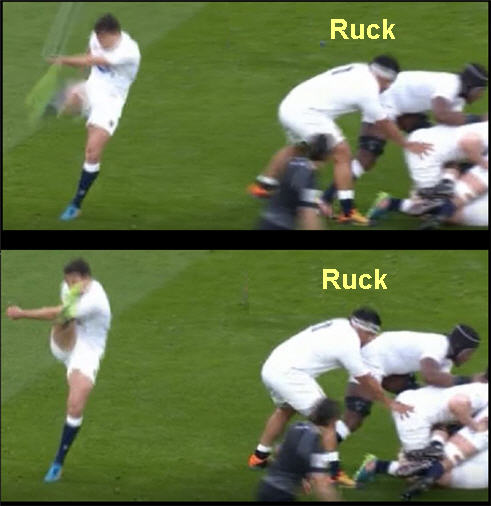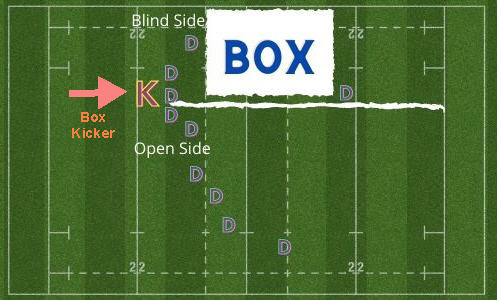Box kicking in rugby is often unpopular with fans who see it as a cheap way to give the ball to the opposition.
But a good box kick doesn’t just get teams out of tough defensive situations.
When a well-aimed box kick is coupled with chasing players competing for the ball, it can be a very effective attacking technique.
What Is A Box Kick In Rugby?
A box kick in rugby is when the kicker punts the ball high over a shoulder toward the blind side of the pitch and behind the first line of defensive players.
The kicker aims for a “box” formed by the area between the nearest touchline and the opposition’s first and last line of defense.
Box kicking is a specialist skill that is almost always executed by the scrumhalf. Teams usually box kick from the back of a ruck or scrum within their own half.
Let’s break this down a little further.
Box kicking Over The Shoulder
When a scrumhalf is about to box kick, they are usually behind a ruck or a scrum. This means that the opposition forwards are close by!
The nearest defenders will likely try to charge down a kick, which is why nines angle their body away from the onrushing opposition.
Look at this still from a Six Nations match between Ireland and England. The Irish scrumhalf has dropped the ball while swinging his kicking foot.

He is milliseconds from making contact with his kick. England flanker Maro Itoje has started his charge.
If I widened the shot, you’d see that the scrum half is facing toward the corner flag of his own try line. So, he has to kick the ball up and over his left shoulder to send it toward the opposition’s half.
Ireland has a reputation for being a little overfond of Guinness and box kicks! To be fair to my home country, I’ve grabbed some more stills from the same match – but with the England scrum half.
Ben Youngs has just made contact with the ball. You can see from the “follow through” that he is kicking over his shoulder.

How Did The Box Kick Get Its Name?
Most kicking in rugby aims to target the area on the field with the least number of defenders. Box kicking is no exception.
When the scrum half is behind a ruck, the first line of defense isn’t very far away! Hence the need to kick the ball upward!
Once the kick is away, the defending players will turn to chase back down the field. Below is a still that I’ve marked up to explain further.

I’ve drawn one imaginary dotted line across the width of the pitch to represent the first line of defense. A good box kick must clear this line.
Defending teams typically leave one or two backs downfield to deal with long kicks. This is the last line of defense.
Poor box kicks
A box kick has gone too long if these back-field defenders simply have to stand their ground and let the ball fall into their arms.
The scrumhalf’s teammates have no chance of racing downfield to put pressure on the catching player.
Good box kicks
A good kick will land in empty space between the first line and last line of defense. Of course, the defenders are rushing to fill that space from the moment the ball is kicked.
But defense is more difficult when you have to move into new positions with the attacking team breathing down your neck!
Box Kicking Up The Blind Side
Let’s use this diagram again to focus on the blind side, marked at the top.

The blind side is the side that is closest to one of the touchlines. It may also be called the short side or the narrow side.
Why it’s called a box kick
We’ve mentioned three boundaries:
- the first line of defense
- the last line of defense
- the boundary of the blind side
The thick white line in the diagram shows the fourth boundary.
These four boundaries give us the “box” for box kicks. This is how the box kick gets its name.
Box Kicking To Touch
When the team in possession of the ball are behind the 22-meter line, the scrum half may try to box kick the ball over the touchline and out of play.
As this gives the lineout to the opposition, the goal is to get the kick as far up the touchline as possible.
Bear in mind that scrumhalves are kicking over their shoulder!
They also train to keep their head down during the kick. Getting the right aim and trajectory is a difficult skill.
Let’s take a quick look at one of the masters in action. The best box kick in this situation will land close to the halfway line. Murray gets pretty close!
Box Kicking To Contest For Possession
You’ll find plenty of rugby fans who hate box kicks!
But when their winger hares up the field and out-jumps the defenders to gather the ball, they’re cheering as loudly as everybody else.
A clean catch is preferable, but often the winger will jump and tap the ball back towards their teammates.
This video is an example of an excellent box kick coupled with a good chase.
England scrum half, Ben Youngs, nails the trajectory into the “box”.
Winger Jonny May actually fumbles his catch, but he turned when he jumped to avoid a knock-on, and his team regains possession of the ball.
Box Kicking To Pressurize The Opposition
The worst box kicks go too far down the field to allow chasing players to get anywhere near the defender who catches the ball.
A good winger or full-back can launch a devastating attack from this position.
However, when the scrum half gets the aim and trajectory right, the opposition receives the ball and an opponent at the same time. This can put them in a weak attacking position.
Let’s take a quick look at an example. Yes, it’s Ireland box kicking again.
But I think Ireland has an undeservedly bad rap. It’s not as if other teams don’t box kick!
Here’s the England scrum half from the same match. And this is an excellent box kick.
Why Box Kicking Has Become Less Effective In Rugby
An effective box kick gives chasing teammates the opportunity to tackle catchers immediately and bring them to the ground.
If there were no laws in rugby, then the opposition would simply block the rushing chasers to prevent them from reaching the catcher.
We have a separate article on blocking in rugby that gives examples of subtle blocking that avoids the referee’s whistle.
The next video shows you a beautifully subtle block on the chase of a box kick.
The end result was that the catcher got a pass away to a teammate and the opposition launched an attack.
Box Kicking Within The Defending Team’s Half
It’s rare to see a box kick in the opposition’s half of the pitch. The exception is when the referee is playing advantage for a penalty infringement.
What’s so special about box kicking with a penalty advantage?
If a defender catches the ball during the advantage, the referee will stop play and award the penalty from the place of the infringement.
So, the attacking team regains possession and hasn’t “given the ball away” in a good attacking position.
The hope with the box kick in this scenario is that the defending team is caught out by an unexpected play. This can give a chasing player (usually a winger) the opportunity to catch the ball.
This is just my opinion, but French teams seem to employ this tactic more than other nations. I’ve seen them score tries this way both at club and international level.
Is It Only The Scrum Half Who Takes A Box Kick?
In my decades of watching rugby across the world, I’d confidently say that over 99% of box kicks are taken by the scrum half.
However, the fly half and outside backs will also practice the skill for rare occasions when a scrum half isn’t available.
This can happen when the starting and substitute nine are both injured during play. Either the substitute fly half or an outside back must fill in for the crucial nine duties.
It’s fascinating to watch whether they can execute a good box kick. But many fly halves played nine at a younger age, and are reasonably competent at the skill.
When Did Box Kicking Become Common In Rugby?

Box kicking became common in rugby when the Welsh international teams of the 1960s and 70s used the technique to devastating effect.
Gareth Edwards, their legendary scrum half, perfected the art of kicking high over his shoulder to allow his teammates to chase and gather the ball.
The Welsh were the dominant force in European rugby in that era. It certainly wasn’t all down to box kicking, which was just one weapon in an awesome artillery!
Before the sixties, kicking was almost exclusively the preserve of the fly half.
Edwards changed this to the common practice that we see today, where scrum halves share the role of kicking for territory and attacking positions.
The other change that came with the box kick was the role of wingers. You may be surprised to learn that hookers weren’t usually the ones to throw the ball into a lineout. Wingers often took that role.
But box kicks require a good chase from the blind side wing, so wingers stopped going off the field to take the throws.
Rugby Quiz!
Think you know your rugby?
Let's see if you can match the quote to the player or coach!
Here are seven quotes. How well will you do?
